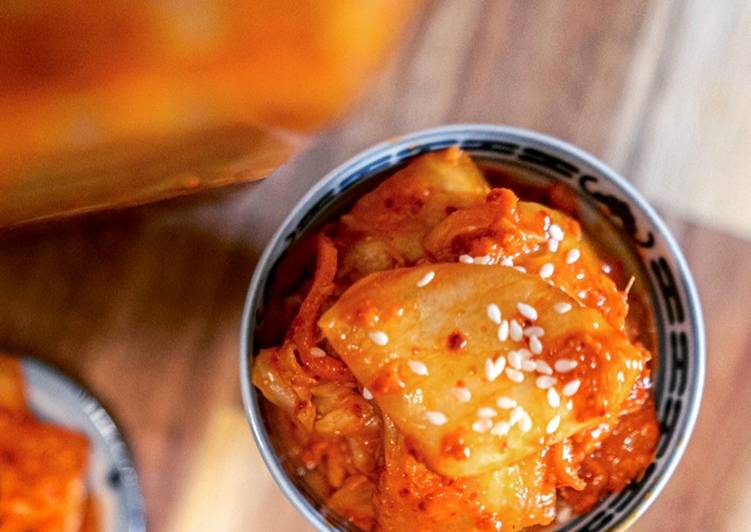Korean Kimchi. Repeat layering all of the cabbage has been salted. Kimchi (김치) is a collective term for vegetable dishes that have been salted, seasoned, and fermented. The history of kimchi goes back to ancient times.
 Kimchi is a fermented dish, the more it ages the better it tastes, likewise with the sugar. Use a persimmon in place of the apple, if you prefer. Combine paste, carrots, green onion, and cabbage until it's all well-coated. You can have Korean Kimchi using 12 ingredients and 16 steps. Here is how you achieve it.
Kimchi is a fermented dish, the more it ages the better it tastes, likewise with the sugar. Use a persimmon in place of the apple, if you prefer. Combine paste, carrots, green onion, and cabbage until it's all well-coated. You can have Korean Kimchi using 12 ingredients and 16 steps. Here is how you achieve it.
Ingredients of Korean Kimchi
- Prepare of Paste.
- It's 1 Cup of Korean Chill Flakes.
- Prepare 1 TBSP of Fish Sauce.
- You need 15-20 Cloves of Garlic.
- It's 4-6 Inches of Ginger.
- You need 1/2 of Cap Coarse Sea Salt.
- You need 4 TBSP of Miso Paste.
- You need 1 TBSP of Sugar or 1 Slice of Asian Pear.
- Prepare of Vegetables.
- It's 1 of Napa Cabbage.
- It's 2-3 of Carrots.
- It's 2 Bunches of Spring Onions.
Pack the kimchi into glass jars leaving room at the top. Fold the extra leaves and press them into the top to hold down the smaller leaves. This will save you from using fermentation weights. Directions Kimchi (김치) consists of cabbage that has been salted and fermented, over a number of days, in a spicy sauce made up from a large number of ingredients including chilli powder, spring onions, fish sauce and onion.
Korean Kimchi instructions
- Cut napa cabbage into quarters, each quater into squares (approx 2 inches square).
- Shred carrots and chop green onions.
- Put chopped and shredded vegetables into a large mixing bowl.
- Sprinkle salt into the bowl.
- Massage and coat vegetables evenly with salt until they wilt.
- Fill the bowl with clean cold water.
- Soak it for 1.5 - 3 hours.
- Peel Garlic.
- Skin & cut ginger into small pieces.
- Put all paste ingredients into the food processor and blend until the texture is consistent.
- Drain vegetables and dry them as much as possible..
- Put drained vegetables back into a large bowl.
- Add kimchi paste in and mix it evenly.
- Find a large jar and jam pack it in.
- Seal it toght but, open it daily and poke it with a clean utensil to let air out.
- The longer you keep it the stronger it gets. It’ll be ready to consume almost immediately. However, I recommend to let it ferment for at least 2 days..
Kimchi is to a Korean as ketchup is to an American. You can eat a meal without it, but it tastes so much better with it. In fact, when I eat pizza or used to eat a hamburger, I sometimes craved kimchi along with them. The crisp, crunchy, spicy cabbage with a hint of sour taste, cleansed my palate after eating meat. Today I'm going to show you how to make classic, spicy, traditional napa cabbage kimchi called tongbaechu-kimchi, a.k.a. baechu-kimchi or pogi-kimchi.
Comments
Post a Comment